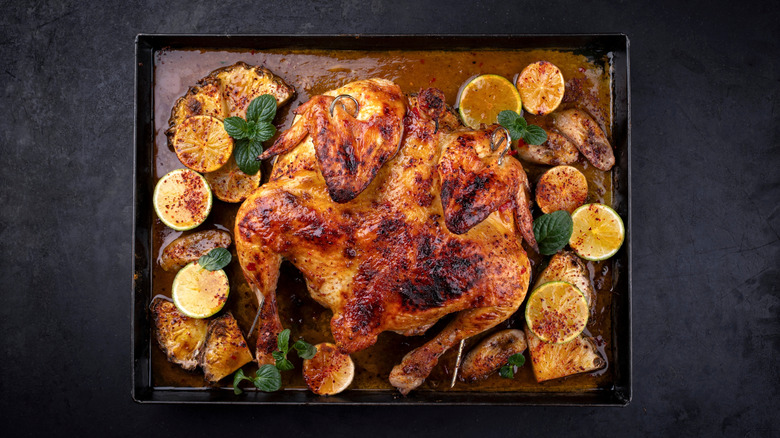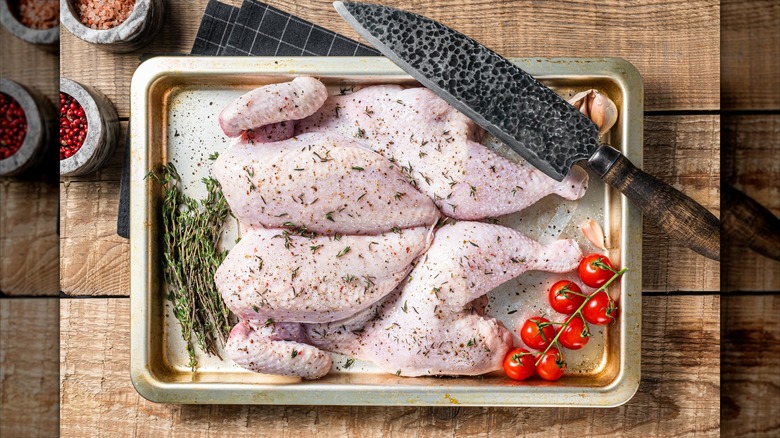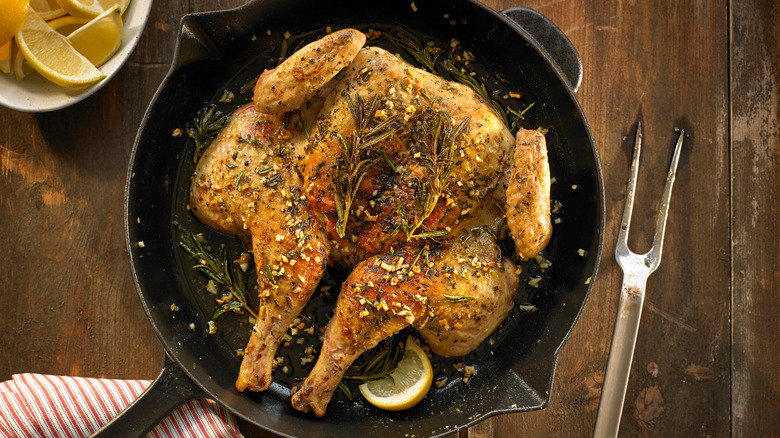Spatchcocking Is The Chicken Prep Trick You Need For Crispy Skin
We may receive a commission on purchases made from links.
Roasted chicken is a classic comfort food and a beautiful meal for entertaining dinner guests. But getting the skin to come out just the right amount of crispy can be a tricky task, especially if you're roasting the bird with the legs trussed and wings tucked. A whole traditionally roasted chicken can end up with skin that's flabby on the bottom and overcooked on top. You can crank up the heat in your oven for crispier skin, but that method can potentially lead to meat that's on the drier side. Instead, get a leg up on roasting the crispiest, juiciest, and most succulent chicken by spatchcocking the bird before it goes into the oven.
Spatchcocking is a bird butchering method that involves removing the backbone so the chicken lays flat as it roasts as opposed to being tucked on top of itself. Spatchcocked chicken will lay with most of the skin facing up and meat facing down, ready to roast in its own juices. Keeping the skin above any liquid in the pan helps it to become crispy as it cooks. Spatchcocking is also a great way to impress guests with a slightly different presentation than traditional roasted chicken, especially if it's surrounded by fragrant and hearty rosemary and garlic roasted potatoes.
How to spatchcock a chicken
Spatchcocking a chicken is a similar technique to butterflying chicken and it's easy to mix up the two. Both butchering methods open the chicken flat, flipping it open like a book. But, butterflying refers to just part of the bird. You butterfly boneless skinless chicken breasts; you spatchcock a whole chicken. Spatchcocking works on chickens of all sizes, from small birds like Cornish hens to 5.5-pound chickens, as well as larger birds, like a basic roasted turkey .
When you spatchcock a chicken, you cut out the backbone of the bird, and that's easiest done with kitchen shears. The sharper the shears, the easier spatchcocking will be, so use something like Misen's Heavy Duty Kitchen Shears for the job. After your bird has been thawed and is ready for cooking, place it on parchment paper in a baking sheet with the backbone facing up and the tail facing toward you. When cutting out the backbone, drive those kitchen shears through the back ribs and completely remove the backbone along with any attached meat and skin. Next, you'll flip the chicken over so the breast is facing up; don't forget to crack the ribs, otherwise the carcass won't lay flat. The body, wings and legs should be evenly distributed on your baking sheet and all on the same level.
How to get perfectly crispy spatchcocked chicken every time
Crispy chicken isn't guaranteed just because it is spatchcocked, though the butchering method increases your chances. If you want a perfectly crisp and juicy roasted chicken, use a few other tricks as well. Once your chicken is spatchcocked and ready to go, pat it dry with a paper towel. It's harder to get crispy skin with a wet chicken, so pull as much moisture out as possible. You can sprinkle salt on the chicken and store it in the fridge overnight to further dehydrate the bird. Another way to dry out chicken is to coat it with salt, baking powder, and pepper, then let it sit uncovered in the fridge overnight (or up to 24 hours). When you're ready to roast, make sure the skin on the chicken is lying flat, as it could have gotten squished during spatchcocking. Then coat it in olive oil and seasonings like salt, pepper, garlic powder, paprika, and fresh thyme before putting it in the oven.
Roast your chicken over a bed of sliced lemon and shallots for a savory, citrusy punch of acidity, or try adding some cinnamon to your roasted chicken for a festive flavor. Whether you're smoking, grilling, broiling, or baking, spatchcocking a chicken will lead a crispier and more evenly cooked chicken with a faster cooking time than traditional roasting.


